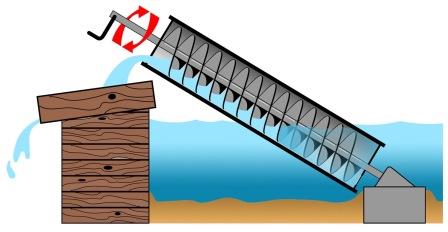February 21, 2017

Screw conveyors are one of the most reliable and cost-effective methods for conveying bulk materials. Due to their versatility, screw conveyors can convey a wide variety of bulk materials ranging from dry, free-flowing portland cement to wet, sluggish dewatered biosolids.
Screw conveyors can be designed to operate in almost any position, from horizontal to vertical. Inclined screw conveyors are used to convey and elevate bulk materials from one level to another. Depending upon the bulk material and the objective, proper design and construction of an inclined screw conveyor will provide many years of uninterrupted service and productivity. The purpose of this article is to help the reader understand the basics of inclined screw conveyor design for various applications.
History of Screw Conveyors
Archimedes designed the screw conveyor in the third century B.C. The first screw was used for removing water from ships and for irrigating farmland. The original device consisted of spiral flights fixed to the inner wall of a hollow cylinder driven by a center shaft. As the assembly rotated, water was conveyed and lifted from one location to another. The spiral design is based on the theory of the inclined plane. The screw conveyor has evolved in modern times and is now used in almost every major industry. Today, thousands of processing plants throughout the U.S. and the world are using screw conveyors to convey bulk materials from A to Z (Adipic Acid to Zinc Concentrate).
Typical Applications for Inclined Screw Conveyors
Inclined screw conveyors solve the basic need for conveying bulk materials a specific distance while elevating it. Because of equipment stack up, inclined screw conveyors are needed to create the optimum plant layout and reduce the number of pieces of equipment in the process flow. Typical applications for inclined screw conveyors include receiving bulk materials from a screener and transferring it to a bucket elevator or as part of a bulk bag discharge system. There are thousands of successful applications for inclined screw conveyors currently in use today.
Classification of Bulk Materials
Bulk materials are classified by particle size, flowability, and other physical properties. The Conveyor Equipment Manufacturers Association (CEMA) provides material classification codes for the most commonly conveyed bulk materials. This information is available in CEMA Book No. 350. The material classification code for each material describes the density, particle size, flowability, abrasiveness, and other important factors. Proper design of inclined screw conveyors is dependent upon the physical properties of the bulk material to be conveyed.
Basic Theory and Design
Screw conveyors are volumetric conveying devices. With each revolution of the screw, a fixed volume of material is discharged. The purpose of a screw conveyor is to transfer product from one point to the next. Screw conveyors are always control fed at the inlet by another conveyor or metering device. Rotary valves, screw feeders, belt conveyors, grinders, or even other screw conveyors typically are connected to the inlet of a screw conveyor.
The flowrate or capacity of a screw conveyor is measured in cu ft/hr. If the capacity is given in lb/hr, tn/hr, or bu/hr, it must be converted to cu ft/hr. Unlike “flood fed” screw feeders, screw conveyors are control fed at the inlet and therefore, the cross-sectional trough loading is less than 100 percent. CEMA has developed standards for trough loading based on the material classification codes. The percentage of trough loading allowed is determined by the bulk material characteristics and if applicable, the obstruction of internal hanger bearings. When necessary due to excessive screw pipe deflection, hanger bearings are located inside the conveyor and are used to support the screw.
Certain parameters are required for sizing a screw conveyor. The capacity calculation for screw conveyors takes into account the outside diameter of the screw, the outside diameter of the center pipe, the pitch of the screw, and the trough loading. The calculation determines the capacity that will be conveyed with each revolution of screw rotation. Most CEMA-approved screw conveyor manufacturers have the capacity calculation and the CEMA guidelines as part of their screw conveyor design software.
Inclined Screw Conveyors
Inclined screw conveyors typically operate from slightly above the horizontal position to 45 degrees from the horizontal position. Above 45 degrees an inclined screw conveyor is considered a vertical screw conveyor and must be designed in accordance with the CEMA guidelines for vertical screw conveyors. As the degree of incline increases, conveying efficiency is reduced and horsepower requirements increase due to the effects of gravity and bulk material fall back. Conveying efficiency is affected by angle of incline, characteristics of the specific bulk material, type of screw conveyor trough, and screw pitch. CEMA recommends designing screw conveyors using the lowest possible degree of incline for maximum efficiency.
Designing Inclined Screw Conveyors
When designing an inclined screw conveyor, it is important to understand how the construction features affect the flowrate or conveying capacity. Selecting the proper trough type and screw pitch will greatly increase the conveying efficiency.
Two types of troughs are typically used with inclined screw conveyors: U-trough and tubular housing. The U-trough design is simple, economical, and provides access for maintenance. U-troughs are used in most horizontal screw conveyor applications and inclined applications up to about 20 degrees. As the degree of incline increases, U-troughs become inefficient because bulk materials will fall back over the top of the screw flights in the open area of the U-trough. Tubular housings are used in most inclined screw conveyor applications above 20 degrees. Conveying efficiency is greatly improved because bulk materials are contained within the tubular housing and fall back is reduced.
Proper selection of screw pitch is also very important for successful inclined screw conveyor operation. Screw pitch is the measurement from the tip of one flight to the tip of the next. Full pitch screws have a measured pitch equal to the outside diameter of the screw. CEMA has developed standard pitches for screw conveyors: full pitch, short (2/3) pitch, and half (1/2) pitch. Full pitch screws are typically used in horizontal screw conveyors because there is no loss in conveying efficiency. As a screw conveyor is inclined, a full pitch screw will lose efficiency due to the angle of the flight.
Pitch Efficiency
The pitch efficiency chart shows the relative conveying efficiency at different degrees of incline and pitch configurations. As the degree of incline increases, reduced pitch screws (1/2 and 2/3) are more efficient than full pitch screws. As pitch decreases, the perpendicularity of the flight to the pipe improves, thereby improving the carrying angle on the incline. The combination of reduced pitch screws (1/2 and 2/3) and tubular housings provide the highest conveying efficiency.
Design and Construction Features to Consider for Inclined Screw Conveyors:
• Incline Up to 10 Degrees – Loss in conveying efficiency is minimal on inclines up to 10 degrees. A screw conveyor with U-trough and full pitch screw is sufficient for most applications. Loss in efficiency can be overcome by increasing the speed of the screw conveyor, increasing the diameter of the screw conveyor or reducing the pitch of the screw.
• Incline Between 10 and 20 Degrees – Loss in conveying efficiency is typically between 10 and 40 percent on inclines up to 20 degrees. A screw conveyor with U-trough and 2/3-pitch screw is sufficient for most applications. Loss in efficiency can also be overcome by increasing the speed or the diameter of the screw conveyor. Additional horsepower is required to overcome gravity and bulk material fall back.
• Incline Between 20 and 30 Degrees – Loss in conveying efficiency is typically between 10 and 70 percent on inclines up to 30 degrees. A screw conveyor with tubular housing and reduced pitch screw (1/2 or 2/3) is recommended for most applications. Loss in efficiency can also be overcome by increasing the speed or the diameter of the screw conveyor. Additional horsepower is required to overcome gravity and bulk material fall back.
• Incline Between 30 and 45 Degrees – Loss in conveying efficiency is typically between 30 and 90 percent on inclines up to 45 degrees. A screw conveyor with tubular housing and reduced pitch screw (1/2 or 2/3) and larger diameter is recommended for most applications. Increasing the speed of the screw conveyor is also required. Additional horsepower is required to overcome gravity and bulk material fall back.
Horsepower Requirements and Upset Conditions
The horsepower requirements for inclined screw conveyors increase with the degree of incline. Additional horsepower is required to overcome gravity and bulk material fall back. Screw conveyors located on inclines over 10 degrees must be designed to start and operate under upset conditions. An upset condition is caused when normal flow in an inclined screw conveyor is interrupted and the bulk material inside the conveyor slips back to the lower end, partially filling up the conveyor. Additional horsepower is required to restart and convey the bulk material because the conveyor will temporarily experience 100 percent trough loading. Please consult a trusted screw conveyor manufacturer for the proper design of inclined screw conveyors for upset conditions.
Conclusion
Inclined screw conveyors are used in thousands of applications and provide a simple solution for conveying and elevating bulk materials. If you utilize inclined screw conveyors in your plant, proper design is extremely important to the long-term success of your operation. Testing of bulk materials may be required in order to determine the correct design for your specific application. Most CEMA-approved screw conveyor manufacturers have a lab for testing bulk materials at various degrees of incline and can recommend the proper design and construction features. The test information for bulk materials that have been successfully conveyed in inclined screw conveyors is typically kept in a database for use on future projects.
Bill Mecke, P.E. is president and owner of KWS Manufacturing Company, Ltd, one of the largest screw conveyor manufacturers in the U.S. He has more than 25 years of experience in the bulk material handling business. For more information, visit www.kwsmfg.com.
For related articles, news, and equipment reviews, visit our Mechanical Conveying Equipment Zone
Click here for a List of Mechanical Conveying Equipment Manufacturers
You May Also Like


